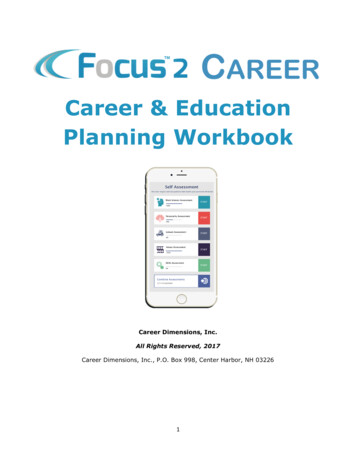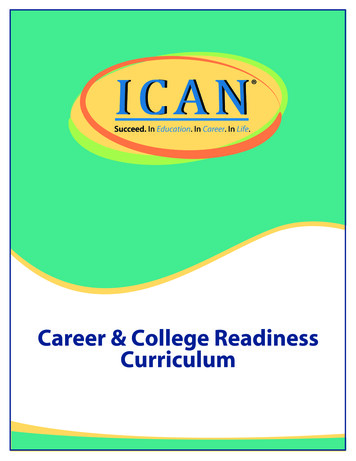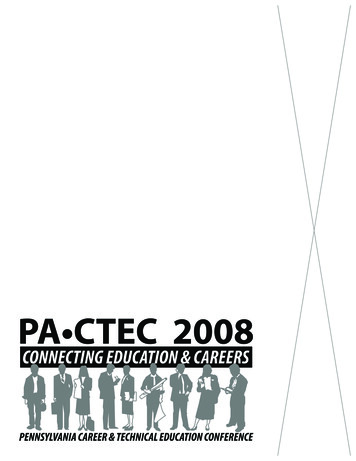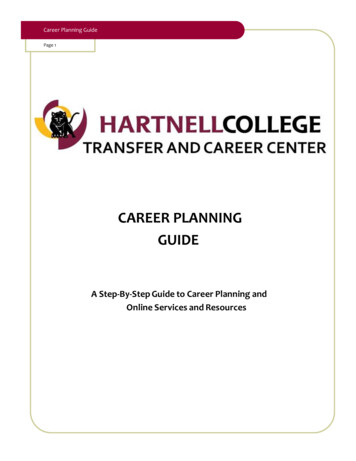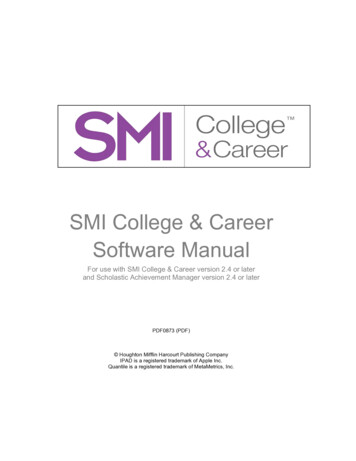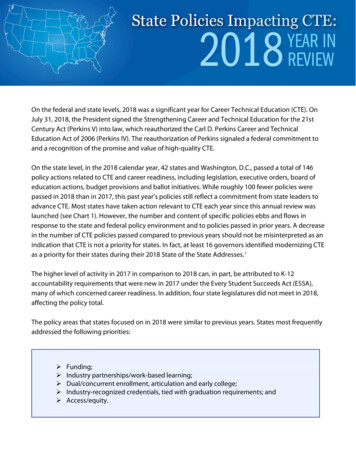
Transcription
Career & TechnicalEducation2019 UpdateE D G A RC I AR EG I O N O N E ES C - C T E S P EC I A L I S TE M A I L - E D G A RC I A @ ES C 1 . N E T, O F F I C E P H O N E - 9 5 6 - 9 8 4 - 6 2 4 3
Review A-F Accountability & CTE 86th Legislature – High Lights Proposed Programs of Study Perkins V
A-F Accountability & CTECCMR Indicators for HS, K – 12, andDistrictsCollege Ready Meet criteria of 3 on AP or 4 on IBexaminations in any subject Meet TSI criteria (SAT/ACT/TSIA/CollegePrep course) in reading and mathematics Complete a course for dual credit(9 hours or more in any subject or3 hours or more in ELAR /mathematics) Earn an associate’s degree Complete an OnRamps course in anysubject and earn college credit*Military ReadyCareer Ready Earn an industry-based certification CTE coherent sequence courseworkcompletion and credit aligned withapproved industry-based certifications(one-half point credit) Graduate with completed IEP andworkforce readiness (graduation typecodes 04, 05, 54, or 55) Earn a Level I or Level II certificate* Graduate under an advanced degreeplan and be identified as a currentspecial education student* Enlist in the United States Armed Forces 2019 Division of Instructional Leadership, School Improvement, and College Readiness Support*new for 20193
CTE and Industry-BasedCertifications The updated list of industry-based certifications (administered bycertification body; i.e. trade association) is scheduled to go intoeffect for the 2019–20 school year and will apply to accountabilityratings in August 2021. To view the updated list, visit: https://tea.texas.gov/cte/ Additionally, the list of CTE courses aligned with an industry-basedcertification will include 19 additional courses by which a CTE coherentsequence graduate may earn 0.5 credit toward CCMR. To view the updated list of aligned CTE courses, lopment/ 2019 Division of Instructional Leadership, School Improvement, and College Readiness Support4
CTE and Industry BasedCertificationsCTE Coherent Sequence Coursework TransitionCCMR IndicatorCTE coherent sequence graduates whocomplete and receive credit for at least oneAccountability Years2019 and20202021andBeyond½ pointaligned CTE courseEarn an industry-based certification1 point1 point 2019 Division of Instructional Leadership, School Improvement, and College Readiness Support
Level I and Level II Certificates Level I and Level II certificates are awarded by an institution ofhigher education (IHE) certifying the satisfactory completion of ahigher education program. Level I certificates are awarded for completing a programconsisting of at least 15 and no more than 42 semester credithours. Level II certificates are awarded for completing a program of atleast 30 but not more than 51 semester credit hours. s Certificates%20and%20Certifications.pdfHandout 2019 Division of Instructional Leadership, School Improvement, and College Readiness Support
HB3 Highlights - CTE Requires that at least 55% of the funds allocated to districts for CTE bespent directly on the programs. Extends the weighted allotment to CTE course enrollments for grades 7-8. Designates Technology Applications curriculum as CTE and providesweighted funding for course enrollments in grades 7-12. Designates the CTE allotment as equal to the unadjusted basic allotment x1.35 weight, Allows the transportation allotment to be used for taking students to/fromlocations for work-based learning. Establishes a new grant program to fund CTE courses in summer. Re-establishes a state subsidy for the cost of certification exam fees passedby students enrolled in CTE programs.
Texas Education AgencyPrograms of Study Definition Incorporates challenging state academic standards Addresses academic, technical, and employability skills Aligns with the needs of industries in the state, regional, and/or localeconomy Progresses in specificity, beginning with all aspects of industry andleading to more occupation specific instruction Has multiple entry and exit points that incorporate credentialing Culminates in the attainment of a recognized postsecondarycredential
Highlights of New POS CTE course sequences for success in high-demand, high wage, highskills careers in Texas Allows for flexibility in district and campus offerings Leads to postsecondary credentials Expand opportunities in STEM occupations Resources for scheduling and career planning available Address the needs of community by creating regional courses throughworkforce data
Benefits of POS Career path for students to postsecondary or workforce Align education with the regional economy Better data collection and reporting CTE concentrators Stronger TEKS between course standards and job skills, as perrecommendations Allows for flexibility in alignment of teacher certification to CTE coursesequences.
POS Implementation Considerations Course sequence in POS will be used for federal reporting of CTEconcentrators CTE Concentrator completion of two CTE courses for two or morecredits within a POS. As per Perkins V. CTE Completer completion of three or more courses for four or morecredits, including level three or level four course. Perkins funds can be used to support statewide or approved regionalprograms of study.
Changes to Career Cluster Combined:1.Business Management & Administration2.Marketing and FinanceCombined:1.Law, Public Safety, Corrections & Security2.GovernmentEmbedded throughout:1.STEMAdd:Energy Cluster
Public Comments-Feedback Add Energy Cluster to Chapter 130 Allow additional STEM focused POS Allow Innovation courses to serve as final course in sequence to earnendorsement. Allow AP courses to count toward an endorsement within a CTE POS. Allow new Innovative courses to be developed to meet skills gap. Consider revisions to prerequisites for courses Revise the Advanced List of CTE course for CTE funding Allow for proposed Practicum in Entrepreneurship to meetendorsements across multiple career clusters.
Programs of Study –Resources Link
Programs of Study-Clusters
Programs of Study -Alignment
POS Timeline2019 – 2020 – Planning year2020 – 2021 – Year 1 Implementation, collect concentrator data, nomonitoring2021 – 2022 - Year 2 Implementation, collect concentrator data, nomonitoring2022 – 2023 – Year 3 Implementation, collect concentrator data, withmonitoring2023 – 2024 – Year 4 Implementation, collect concentrator andcompleter data, with monitoring
Perkins V – Approved July 31, 2018 Will go into effect July 1, 2019 2019 – 2020 will be considered a transition year. Major Components of Perkins V: Introduces a comprehensive local needs assessment and update everytwo years. Allows support for grades 5-8. Collection and desegregation of data by POS or CTE programs Define CTE concentrator to include in accountability systems
Inspirational StoryCoach Robert MendezTeacher/CoachBorn with no arms & no legsInspire othersBelieve in your self!Believe in what you do!Develop a can do attitude!
Inspirational StoryCoach Robert Mendez
ContactEd GarciaRegion One ESC – CTE Specialistedgarcia@esc1.net(956) 984 – 6243orHeather Justice, CCMR Division Director,heather.justice@tea.texas.gov .
Career path for students to postsecondary or workforce Align education with the regional economy Better data collection and reporting CTE concentrators Stronger TEKS between course standards and job skills, as per recommendations Allows for flexibility in alignment of teacher certification to CTE course sequences.
